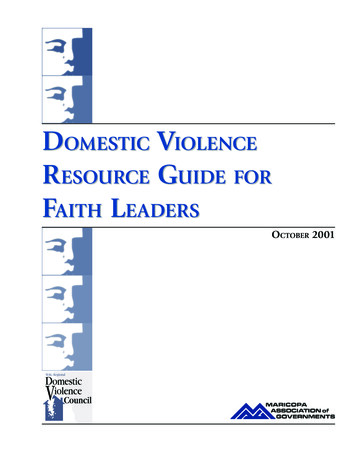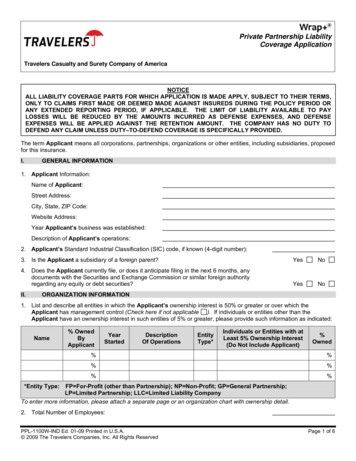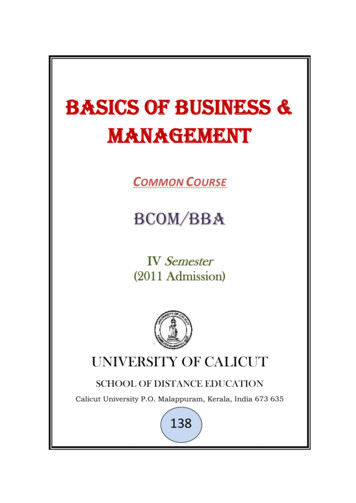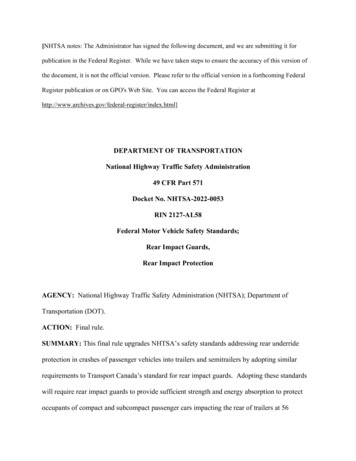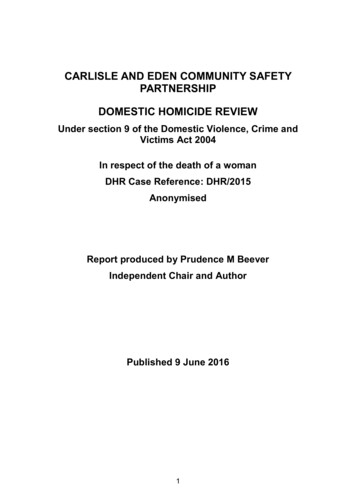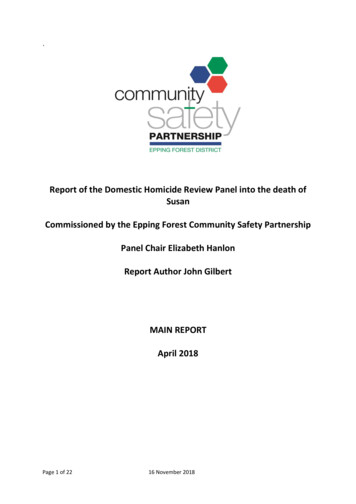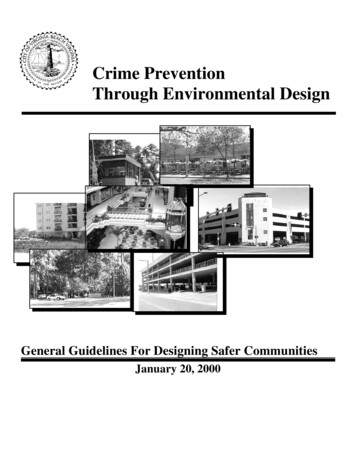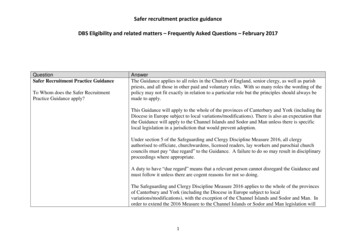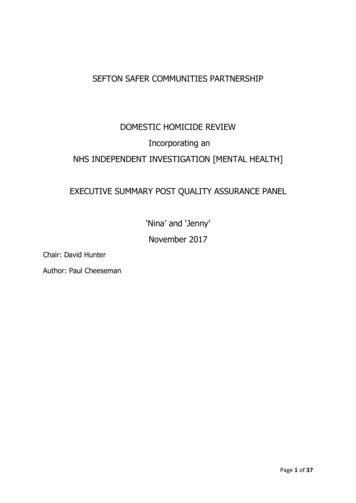
Transcription
SEFTON SAFER COMMUNITIES PARTNERSHIPDOMESTIC HOMICIDE REVIEWIncorporating anNHS INDEPENDENT INVESTIGATION [MENTAL HEALTH]EXECUTIVE SUMMARY POST QUALITY ASSURANCE PANEL‘Nina’ and ‘Jenny’November 2017Chair: David HunterAuthor: Paul CheesemanPage 1 of 37
CONTENTSSECTIONPAGE1.Introduction32.Establishing the Domestic Homicide Review4–63.Background74.Key ommendations14–15Appendix APanel Recommendations & Action PlansAppendix BAgency Recommendations & Action PlansPage 2 of 37
1.INTRODUCTION1.1This case is about the homicides of Nina and her adult daughter Jenny. Theperpetrator of the homicide was Dean. This Domestic Homicide Review discoveredthat at the time of the deaths of his sister and mother, Dean had a substantial historyof criminal offending for possessing drugs, burglary, damage and assault. He also hadmental health needs that were identified within the prison system in 2010, although aformal diagnosis was not achieved until 2013. This was, and remains, a diagnosis ofparanoid schizophrenia and personality disorder.1.2In June 2016 Dean appeared before a Crown court. He admitted the manslaughter ofNina and Jenny. He was sentenced to life imprisonment and will serve a minimum oftwelve years and seven months with a hospital treatment order.Page 3 of 37
2.ESTABLISHING THE DOMESTIC HOMICIDE REVIEW (DHR)2.1Introduction2.1.1Sefton Safer Communities Partnership (SSCP) decided the deaths of Nina and Jennymet the criteria for a Domestic Homicide Review. They appointed David Hunter asthe Independent Chair; he was supported by Paul Cheeseman. They areindependent practitioners who have chaired and written previous DomesticHomicide Reviews, Serious Case Reviews and Multi-Agency Public ProtectionReviews. They have never been employed by any of the agencies involved with thisDomestic Homicide Review (DHR). A DHR panel was assembled which representedlocal agencies and included independent members, some with detailed knowledgeof domestic abuse.2.1.2An NHS Independent Investigation should be undertaken when a homicide hasbeen committed by a person who is, or has been, under the care of specialistmental health services in the six months prior to the event. These investigations areconducted under the Serious Incident Framework for England (2015) issued by NHSEngland. Maria Dineen, an approved independent contractor for NHS England, wascommissioned to attend panel meetings and to ensure that the mental healthcomponents of the Domestic Homicide Review met the standard required by NHSEngland. Paul Cheeseman was the author of the report, and the sectionsconcerning mental health were written by Maria Dineen.2.1.3Ten agencies submitted Individual Management Reviews (IMRs). Other agenciesprovided chronologies and relevant information when requested.2.1.4David Hunter met with members of Nina and Jenny’s family. These included Nina’ssister and Nina’s two nieces and nephew. The family was kept informed of thereview’s progress and was provided with a copy of the draft report. They did notrespond to several requests to see them. At the time of the final panel meeting, noresponse had been received from the family.2.1.5As she is a survivor of domestic abuse, the panel felt it was important that theviews of Female One1 were considered. Attempts to contact her have not beensuccessful; these included a personal visit to her last known address.2.2Terms of Reference2.2.1The purpose of a Domestic Homicide Review is to: Establish what lessons are to be learned from the domestic homicide regarding theway in which local professionals and organisations work individually and together tosafeguard victims; Identify clearly what those lessons are both within and between agencies, how andwithin what timescales they will be acted on, and what is expected to change as aresult; Apply these lessons to service responses, including changes to policies andprocedures as appropriate;1Dean claimed Female One was his girlfriend. This is something she rejected.Page 4 of 37
Prevent domestic violence, abuse and homicides and improve service responses forall domestic violence and abuse victims and their children through improved intraand inter-agency working.(Multi-agency Statutory Guidance for the Conduct of Domestic Homicide Reviews[2013] Section 2 Paragraph 7)2.2.2Case-specific termsTerm 1Review the mental health care, treatment and services provided to Dean by theNHS and other relevant agencies, identifying both areas of good practice and areasof concern for the period 1 January 2010 to the date of the homicides.In analysing your agency’s involvement, please pay specific attention to thefollowing sub-terms.Sub-terms1.1 Determine whether professionals:a.recognised any domestic abuse indicators for the principalsb.completed risk assessments [including self-harm] and risk managementplans [RMPs] and managed them appropriatelyc.reviewed or amended RMPs in response to new or changing information1.2 Were the services provided for the principals appropriate to the identifiedlevels of risk?1.3 Examine the effectiveness of Dean’s mental health care plans, including theinvolvement of the service user and the family.1.4Review the application of the Mental Health Act for Dean in both the criminaljustice system and health services.1.5 Review the effectiveness of discharge planning and the application ofappropriate aftercare for Dean.1.6 Were single and multi-agency policies and procedures adhered to andeffective in the management of this case?Term 2What knowledge did your agency have about domestic abuse between theprincipals? What risk assessments were undertaken and what actions were taken toensure the safety of those at risk?Term 3What knowledge did the victim’s family and friends have about domestic abusewithin the family, and what did they do with it?Term 4Page 5 of 37
If there were lapses in service provision to any of the principals, were there issues inrelation to capacity or resources in your agency that impacted the ability to provideservices to the principals and to work effectively with other agencies?Term 5Establish what lessons are to be learned regarding the way in which professionalsand organisations work individually and together to safeguard future victims.Term 6Identify clearly what those lessons are both within and between agencies, how andwithin what timescales they will be acted on, and what is expected to change as aresult.Term 7Were equality and diversity issues – including ethnicity, culture, language, age, faithand disability – considered?Term 8Were issues with respect to safeguarding (adults) adequately assessed and actedupon?Term 9Determine through reasoned argument the extent to which the deaths of Nina andJenny were either predictable or preventable, providing detailed rationale for thejudgement.Term 10Provide a written report to the Home Office and NHS England North that includesmeasurable and sustainable outcome-focused recommendations.Page 6 of 37
3.BACKGROUND3.1Nina was born on Merseyside. She was the youngest of nine siblings. Her parentsare deceased. She had three children; Jenny was one, and Dean another. Theirfather died in 2008. Nina had not worked for several years. At the time of her deathshe lived in sheltered accommodation in Bootle. Her family described her as caring,funny, generous, kind and very well liked.3.2Jenny, who didn’t work, was described by her family as a very clever person whowas top of the class at school, and a gifted musician who played the guitar andpiano. Children loved her. She lived separately, but near to her mother, and theyhad a warm relationship. The review panel heard that Jenny had some mentalhealth needs resulting in challenging behaviour towards her mother and others.Many of these incidents brought her into contact with the police who dealt with herformally and sympathetically.3.3Dean had a troubled past. When he was eight years of age he was aggressive anddidn’t take part in lessons or mix with children. He was referred to Child andAdolescent Mental Health Services. He had special educational needs and wasconsidered by his school to have been one of the most difficult children they everhad to deal with. He had a poor attendance record.3.4In school he became distracted, and would defy staff, swear and throw objects atthem. Nina told an Education Welfare Supervisor that when Dean could not get hisown way, he would punch her in the stomach.3.5Dean has fifteen convictions, including ones for drugs and violence. He servedseveral terms of imprisonment and developed a pattern of attacking staff. He was ahabitual user of cannabis and was suspected of using other illegal drugs. He hasnever worked.3.6This family tribute appeared in a local newspaper: ‘We are absolutely devastatedfollowing the loss of Nina and Jenny and are still trying to come to terms with whathas happened to them They will both be greatly missed.’Page 7 of 37
4.KEY LEARNING4.1The following paragraphs summarise Dean’s history of domestic abuse and mentalhealth illness. Where learning is identified, a cross reference in bold is made to therelevant lesson in section 5 below.Domestic abuse4.2The family say Nina was frightened of Dean. He would telephone and demand herreturn, and he could be heard screaming down the telephone at her. The family sayDean would take advantage of his mother’s kind nature by taking money from her(lesson five). Friends believe Dean was responsible for fracturing Nina’s shoulder.His mother never reported him. There was one report to agencies of a verbaldomestic dispute between Dean and Jenny and several reports of disputes betweenJenny and her mother, although Nina and Jenny’s relationship was, generallyspeaking, a warm one.4.3The panel considered whether there was evidence of controlling and coercivebehaviour and financial abuse by Dean against his mother and sister. There werereports by neighbours to Your Housing Group staff that Nina had to sleepelsewhere when Dean stayed at her flat. That was explored at the time by YourHousing Group and no evidence was found to support the reports. There is noevidence that Dean was financially exploiting his mother or sister. That is differentfrom saying those things did not happen. There is no doubt that Dean exertedsignificant influence over his mother for all his life. She could see no bad in him andwas always ready to defend him. It is very likely that over his lifetime that Deanwas receiving money from his mother and whether she gave it freely cannot beascertained. It is known that he assaulted her and therefore the panel felt it wasreasonable to conclude that he did exert controlling and coercive behaviour over hismother and because of his nature probably his sister; he assaulted her at leastonce. Whether his mother recognised his behaviour as controlling and coercive is adifferent question that cannot be answered with confidence.4.4There were some missed opportunities by agencies to identify that Nina may havebeen at risk of domestic abuse. For example, Nina lived in shelteredaccommodation and a risk assessment was undertaken when she moved there. Thesection concerning domestic abuse was left blank. A routine older personassessment was also undertaken and Nina was not asked direct questions aboutdomestic abuse.4.5Dean entered the sheltered scheme freely and had access to Nina’s flat even whenshe was not there. On occasions, he stayed over in the flat, which meant she hadto sleep in other residents’ flats. The family believe Dean was highly manipulativeand felt he should not have been staying with Nina. The housing provider knewlittle about Dean’s background and felt he was shy and polite (lesson four).4.6When Nina had contact with Aintree Hospital following the fracture of her collarbone, safeguarding was not considered at the hospital presentation (lessonthree).4.7In December 2014 Female One complained that Dean had assaulted and harassedher. He was arrested, charged and remanded in custody. On his release in February2015 the court imposed a restraining order. Dean went to Female One’s addressand breached this order. He left the scene and, because of an oversight, was notPage 8 of 37
circulated as wanted for this offence. Consequently, an opportunity to arrest himwas missed a few days later when he was stopped by a police officer, checked andcautioned for possessing cannabis (lesson seven).4.8Fifteen days after being stopped in the street, Dean entered the shelteredaccommodation where Nina lived and killed her. He then went to Jenny’s homewhere he killed her. He left the area and travelled by train to London, where hewas arrested.Dean’s mental health4.9Between 2010 and 2015 Dean had contact with many specialist mental healthservices in prison and the community. In 2010 he was seen by the Criminal JusticeLiaison Team at Bootle Magistrates’ Court. This followed a referral from G4S, whoreported he was talking to himself in his cell and that he was aggressive to policeduring arrest and detention. The mental health professional wrote:‘He gave the impression that he wanted me to believe he had mental illness.Referred to himself as Schizo and mental. He did not receive a diagnosis at thispoint. There were no indications at this time that he required ongoing mentalhealth input.’ Dean was offered a referral to drug and alcohol services, which herefused.4.10In March 2011 Dean was sentenced to thirty-five months’ imprisonment forburglary and breaching a suspended sentence. Within weeks of his admission hewas referred to an NHS-managed medium-secure hospital because of his paranoidand psychotic behaviours. He was assessed and commenced on antipsychoticmedication. The plan was to review him in two weeks. The working diagnosis wasparanoid schizophrenia.4.11Before his review he was transferred to other prisons. At these locations, it seemsDean was seen by three more psychiatrists, but was moved each time beforereceiving a firm diagnosis (lesson two). Dean was recalled to HMP Liverpool inMay 2013 for breaching his licence conditions. Within three days of his arrival inprison, Dean was assessed by a consultant psychiatrist and restarted onantipsychotic medication.4.12In July 2013 he was transferred from prison to the Spinney, a private mediumsecure hospital. Dean’s main risks at the time of admission to the Spinney areworth noting: Violence including assault with improvised weapons Psychologically driven threats/assaults Threats Frequent periods in segregation Persistent damage to property Suicidal thoughts and self-harm by cutting Poor treatment compliance Serial acquisitive offendingPage 9 of 37
4.13 Possible gang links and victimisation Persistent ill discipline Substance misuse Poor social stabilityHe remained at the Spinney for six months, transferring to HMP Manchester inJanuary 2014 with the following diagnosis:‘Dean has Paranoid Schizophrenia typified by persecutory paranoid delusions andhallucinatory experiences. It would seem, that he has been mentally unwell for twoand a half years. He has been intermittently compliant with medication and hastaken a large amount of cannabis in the form of Skunk.’4.14There are two technical terms relevant to his mental health and this review: Section 117 aftercare, which imposed a duty on health and social services toprovide aftercare services for Dean;Care Programme Approach, for assessing, planning, coordinating andreviewing services for someone with mental health problems.4.15This meant that procedural conditions applied when he was released from HMPManchester to mainstream mental health services in Liverpool in July 2014. At thispoint his case management became the responsibility of Mersey Care NHS Trust,which is now a foundation trust.4.16The transfer was not handled well and key information was not shared. The upshotwas that Dean never received mental health treatment/support. He was offeredappointments but did not keep them, and there was no compulsion to do so(lesson one).4.17Dean was managed through Multi-Agency Public Protection Arrangements (MAPPA)2at Level 2, but was removed from the Level 2 agenda in August 2014. This wasjudged premature given his risks. He posed a very high risk of serious harm to staffand a high risk to the public (lesson six).4.18In November 2014 Dean climbed a crane and hurled pieces of it to the ground.Merseyside Police detained him under Section 136 of the Mental Health Act and hewas assessed at Aintree Hospital. The assessing clinician concluded:‘Dean, has historically been thought, to suffer with a psychotic illness, but I couldelicit no evidence of any psychotic symptoms on assessing him today and would besceptical about this diagnosis.’4.19He was discharged without follow-up by mental health services. Worryingly thepsychiatrist recommended that Dean stop taking his antipsychotic medication.2The Criminal Justice Act 2003 provides for the establishment of Multi-Agency Public Protection Arrangements(MAPPA) in each of the forty-two criminal justice areas in England and Wales. They require local criminaljustice agencies and other bodies dealing with offenders to work in partnership in dealing with those offendersto protect the public from violent and sexual offenders. There are different levels at which offenders aremanaged and categories into which offenders are placed. Level 2 is active multi-agency management. Acategory 3 offender is dangerous: a person cautioned or convicted for an offence which indicates they arecapable of causing serious harm and which requires a multi-agency approach.Page 10 of 37
4.20There was no further contact between services provided by Mersey Care NHS Trustand Dean until 27 February 2015, when his solicitor opportunistically asked theCriminal Justice Liaison Team at Liverpool Magistrates’ Court, where Dean waswaiting to be sentenced for damaging the crane and a police car, to assess him. ACriminal Justice Liaison Nurse met with Dean but did not have time for a fullassessment and arranged for him to be sent an outpatient appointment for a morecomplete assessment by his community mental health team. This appointment wasbooked for 18 March 2015. Dean did not attend.4.21He was offered another appointment, by which time he had been arrested for theunlawful killing of his mother and sister.Page 11 of 37
5.LESSONS IDENTIFIED5.1The IMR agencies’ lessons are not detailed here because they appear as actions inthe Action Plan at Appendix B. The DHR panel identified the following lessons:Lesson oneAlthough the situation that arose between Mersey Care NHS Trust and ManchesterMental Health and Social Care Trust could not now happen, the incompleteinformation transfer in this case highlights the importance of information providershaving a safety step in their processes so that they can ensure that all informationprovided has in fact been received.Lesson twoPrisoners who enter the prison system with mental health issues are at increasedrisk of vulnerability. For those prisoners who require mental health assessments,moving them routinely around the prison estate is not a good plan, as it interruptsthe process of assessment. Therefore, an approach needs to be developed withinthe prison system that enables the continuity of mental health care for thoseprisoners that may need to be moved.Lesson threeProfessionals should be empowered to make routine enquiries of patients or victimsto establish if they can provide information that indicates they are at risk ofdomestic abuse or have been subjected to domestic abuse. Professionals need tobe provided with clear pathways so they understand what should be done with anyinformation they discover.Lesson fourProviders of housing occupied by residents who are elderly, infirm or suffer frommental health issues need to understand that these residents may be vulnerable topersons such as Dean who can exercise coercive behaviour towards them.Providers need to be alert to these dangers, be inquisitive about visitors and whatthey do, and take steps to protect their residents from the risks of controllingindividuals such as Dean.Lesson fiveFamilies and friends of victims sometimes have valuable knowledge about thedomestic abuse a victim has suffered or the way that a perpetrator has behavedthat they do not repeat to others or report to agencies for many different reasons.Information needs to be made available to friends and family so that they knowhow best to support victims, which may include sharing the information withagencies, but at all times recognising the safety of the victim is paramount. This willempower families to have the courage to say something and to know where theycan share information safely. Sometimes families stay quiet because they believethey will make it worse for the abused if they speak out.Lesson sixPoor MAPPA management and adherence to its policies and procedures leads torisks being uncontrolled and potential victims unprotected.Page 12 of 37
Lesson sevenPolice systems need to provide clarity at all times as to who owns an investigation;the actions that need to be taken in cases of domestic abuse; and who hasresponsibility for actions, together with realistic deadlines for these to be completedand monitored that balances urgency against the prevailing demand on, andavailability of, resources.Page 13 of 37
6.CONCLUSIONS6.1The panel concluded there were two important issues to consider in respect ofwhether the homicides of Nina and Jenny were predictable and preventable. Thefirst of these relates to the management of Dean’s mental health. The secondrelates to the missed opportunity to arrest Dean after he breached a restrainingorder.The mental health lapses of greatest significance were: Dean was not managed on the Care Programme Approach, nor did he receivehis entitlement to Section 117 aftercare services following his release fromHMP Manchester.And The recommendation from a psychiatrist to stop his medication was nothelpful.6.2However, managing Dean under the Care Programme Approach would not havemade him engage with mental health services. The Care Programme Approachwould have afforded a more assertive and sustained effort to follow him up whenhe did not attend for outpatient appointments. Successful contact with Dean maynot have been achieved even if assertiveness had been employed. The panelconsidered that the chances of successfully engaging with Dean were low.However, more effort should have been made.6.3The panel was unsure what difference it would have made had there not been arecommendation to stop his medication. Dean said he had stopped taking hismedicine. Had subsequent prescriptions been issued, there is no guarantee that hewould have collected them. In any event, he was not obliged to take them.6.4The panel concluded that in respect of his mental health, the opportunity to dothings differently was missed. Had everything been done correctly, there is noconfidence that the deaths would have been prevented.6.5Dean was not circulated as wanted following the breach of a restraining order. Hewas stopped and given a street caution for possession of cannabis. An opportunityto arrest him was missed.6.6Had Dean been arrested then, or at any time thereafter, for breaching therestraining order on his former ‘girlfriend’ and been remanded in custody, thehomicides of Nina and Jenny might have been prevented on the day they occurred,although this would have provided no guarantee that they could have been avoidedafter his release.6.7Overall the panel concluded that on the balance of probabilities, the homicides ofNina and Jenny were neither predictable nor preventable; there were howevermissed opportunities to lessen the possibility of their deaths.Page 14 of 37
7.RECOMMENDATIONSDHR panel recommendations7.1The panel recommendations appear in the Action Plan at Appendix A and are notdetailed here. The NHS Independent Investigation identified the following.Mental Health NHS Independent Investigation recommendations,improvements made and recommendations outstanding7.2At relevant stages throughout the previous pages, changes that have been madehave been highlighted. The outstanding issues for mental health are set out here.7.3The only change that occurred as a consequence of this case review and otherinquest comments is the new requirement in Lancashire Care Foundation Trust fortheir staff to review SystmOne for relevant information about newly processedinmates.7.4Mersey Care NHS Trust has made a number of changes3 to its centralised approachto the referral and assessment process. While these have not been made as adirect consequence of this case, they do address features of the mental healthomissions in this case.7.5Manchester Mental Health (HMP Manchester) has also made its changes for goodpractice reasons rather than as a consequence of this case. It is not thought theyconstitute ‘lessons learned’ as a consequence of the Dean case. However, this casehas highlighted yet again the central importance of: Uncompromising adherence to safe practice procedures such as Section 117aftercare and Care Programme Approach discharge, as they are designed toensure effective transfer of critical information about a service user.The need for relevant agencies to have access to complete information abouta service user. This case has highlighted the importance of SystmOneprison records to Hospital Psychiatric Liaison Teams, Criminal JusticeLiaison Teams and, I would argue, Crisis Intervention Teams.Mersey Care NHS Trust’s internal assessment and referral processes7.6An outstanding action for Mersey Care Trust is to establish the reliability with whichits staff ensure they have read and assimilated all the information provided about anew patient at the point of referral and acceptance. This did not happen in thiscase. There are a number of ways the trust could achieve this: Via survey methodVia simulation method, in conjunction with safety tools such as FailureModes and Effects AnalysisVia observation and interview methods3All referrals are received by the newly arranged access team. The patient is physically assessed as part of thetriage and then allocated to the appropriate part of the service.Page 15 of 37
The trust is required to set out its action plan for achieving assurance and to sharethis with Sefton Safer Communities Partnership.7.7Mersey Care NHS Trust has revised how it assesses new referrals, and a face-toface meeting with its own team now occurs as normal practice. However, whathappens ‘as a norm’ when a service user is allocated to a community mental healthteam needs to be established. How do community mental health teams ensure that they are appropriatelyknowledgeable about a service user?To what extent is the information known about a service user reviewed andassimilated by a community mental health team?One way to test this would be to simulate Dean’s referral and acceptance intoMersey Care NHS Trust as it occurred in June 2014 and to test its newly revisedsystems to determine what, if anything, would be different. Alternatively, therevised process could be visually mapped and a selection of staff working in andacross the new system brought together to apply the principles of Failure Modesand Effects Analysis to identify any weak points in the system that reasonably couldlead to the information loss that occurred in this case.SystmOne records7.8Most mental health prison in-reach is provided by NHS trusts. However, the clinicaldata is documented on a clinical information system known as ‘SystmOne’, which amental health trust would not have access to outside of the prison setting. Thepurpose of SystmOne is to enable all prison health teams to have access to relevantrecords regardless of what prison a prisoner resides in at any given point in time.For SystmOne to be delivered nationally, access also needs to be available to: The Criminal Justice Liaison Service on a national basisSection 12 Approved Doctors and Approved Mental Health Professionals(AMHP) when they are conducting an assessment under the Mental HealthActHad the SystmOne records been accessible by these two groups of professionals inthis case, the clinical knowledge about Dean would have been enhanced, and staffstrongly believe that they would have acted differently to how they did in respect of: The management plan post-Mental Health Act assessment in November 2014.The two Criminal Justice Liaison Team contacts: one in January 2015, and theother in February 2015. The key difference here would have been theurgency of request regarding subsequent assessment of Dean.Finally, the discharge letter from prison health to Dean’s GP was not clear in respectof his diagnosis at the time of discharge. The formulation of discharge letters needsto ensure that the receiving health professional can quickly see what the currentdiagnosis and treatment needs are.Page 16 of 37
Appendix AAction PlansPanel RecommendationsNo.Recommendation1That Manchester MentalHealth and Social Care Trust(HMP Manchester) andMersey Care NHS Trustreport in writing to SeftonSafer CommunitiesPartnership what actionshave been taken to remedythe identified weaknesseswhen releasing prisonerswho are entitled to Section117 services.SSCP to write to Manchester MentalHealth and Social Care Trust (HMPManchester) and Mersey Care NHSTrust to request an update reportThat in cases in which prisonmental health services haveidentified that a mentalhealth assessment isneeded, the NationalOffender ManagementService ensures that whendecisions are taken to moveoffenders between prisons,the assessment is completedprior to that move. If theprisoner is to be releasedbefore the assessment isSSCP to write to National OffenderManagement Service to request areport outlining the proceduresfor mental health assessmentsfor prisoners, particularly in relation toprison moves and release. This reportshould include any changes toprocesses since th
Domestic Homicide Review (DHR). A DHR panel was assembled which represented local agencies and included independent members, some with detailed knowledge of domestic abuse. 2.1.2 An NHS Independent Investigation should be undertaken when a homicide has been committed by a person who is, or has been, under the care of specialist
